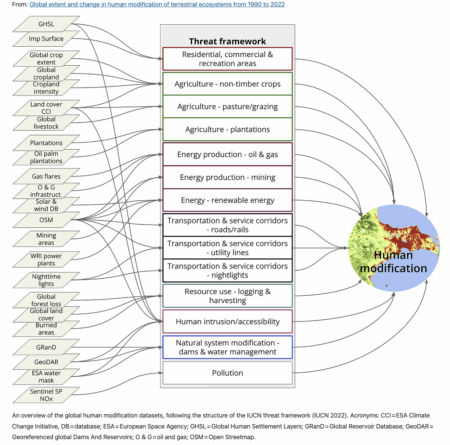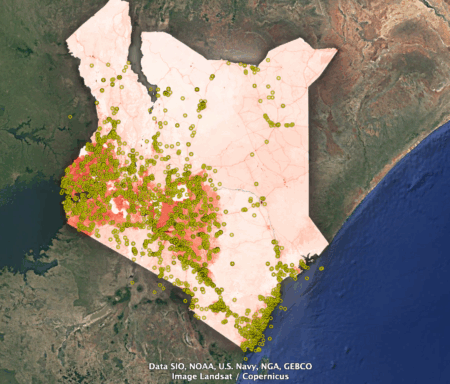- Links between protein-source diversity, household behavior, and protein consumption inadequacy in the Indian rural semi-arid tropics. More diversity in protein sources, including livestock, would probably lead to more consumption, especially if linked to more education on its importance.
- Integrating Local and Indigenous Animal Genetic Resources for Food and Agriculture (LIAnGRFA) into global biodiversity governance. We wont keep livestock diversity for long if we don’t integrate its conservation into existing mechanisms.
- Introduction to chicken genetic resources of India: a comprehensive review. India seems to agree with the above, at least with regards to its chickens, and is doing something about it.
- Out of Africa: genetic characterization and diversity of Mashona cattle in the United States. Something will certainly have to be done about the Mashona in the US if its interesting but limited diversity is to survive.
- Impacts of Climate-Land Dynamics on Global Population and Sub-Populations of a Desert Equid. Ditto for the Asiatic wild ass, although I suppose its contribution to human protein supply is pretty safe.
- Archaeogenomic insights into commensalism and regional variation in pig management in Neolithic northwest Europe. Even Neolithic European farmers managed the diversity of their livestock, pigs in this case.
- Agronomic performance, herbage quality, methane yield and methane emission potential of pasture mixtures. All those diverse livestock might as well be eating the sort of feed that leads to lower methane emissions.
- Ancient dog mitogenomes support the dual dispersal of dogs and agriculture into South America. Domestic dogs were taken into South America along with maize, according to their genetic structure. No word on whether they were used as protein sources.
- Footprints of Human Migration in the Population Structure of Wild Baker’s Yeast. Saccharomyces cerevisiae is something else whose genetic structure was heavily influenced by early farmers, and indeed continues to be by modern farming.
- Revealing the ancient origins of blonde beers: Phylogeography and phylogenetics of cryotolerant fermentative yeast Saccharomyces eubayanus from pre-Hispanic pottery in Northwestern Patagonia, Argentina. Did those early South American farmers ferment their maize, I wonder? They had the yeast for it, which eventually made it to Europe and gave us lager. And no, beer is not a good protein source.
Nibbles: Cherokee Three Sisters, Australian native grains, Ancient Peruvian irrigation, Indian apples, IFOAM Seed Platform, MSB, Chinese conservation, Protected areas, Soybeans breeding, Funding cuts
- Three Sisters rematriated to historical Cherokee Nation.
- Native grains returning to Indigenous land in Australia too.
- May need to bring back agricultural practices too, like in Peru.
- Meanwhile, in India, farmers are trying to grow apples in new places. Go figure.
- Anyway, seems like the IFOAM Seeds Platform might be able to help.
- And genebanks too of course, like the Millennium Seed Bank.
- As part of a comprehensive conservation systems, goes without saying, like in China.
- Which also include climate-proof protected areas.
- It worked for soybeans, after all.
- Well, for now anyway…
Brainfood: Rice breeding, Sorghum parents, Cowpea diversity, Sweet potato double, Lesser yam uses, Tomato breeding, Peanut hybrids, Rice wild relatives, Sorghum genetic erosion
- Future flooding tolerant rice germplasm: Resilience afforded beyond Sub1A gene. You want to make rapid breeding progress? You need the “Transition from Trait to Environment” approach. As far as I can tell, this means that you fix your trait of interest in a pool of elite parents before using it in proper yield breeding.
- Prioritizing parents from global genebanks to breed climate-resilient crops. Yeah but how do you find your trait of interest in the first place. You start with passport and genotyping data from genebank collections of course.
- Cowpea (Vigna unguiculata L. Walp.) landraces in Mozambique and neighbouring Southern African countries harbour genetic loci with potential for climate adaptation. You see what I mean?
- Genetic diversity and population structure of Colombian sweet potato genotypes reveal possible adaptations to specific environmental conditions. Ok, now do you see what I mean?
- Genetic diversity analysis and duplicates identification of new sweetpotato accessions collected in China. Manage your duplicates though, right?
- The lesser yam Dioscorea esculenta (Lour.) Burkill: a neglected crop with high functional food potential. This doesn’t have decent collections, let alone duplicates.
- Molecular screening of wild and cultivated tomato germplasm reveals potential materials for multi-locus disease resistance breeding. Again, thank goodness for genebanks — plural.
- First report on trait segregation in F1 hybrids between the cultivated peanut (Arachis hypogaea L.) and the wild incompatible species A. glabrata Benth. I wonder if this could be used in tomato.
- A blueprint for tapping the wild relatives for crop improvement: A success story of CWR-derived rice varieties, Nông Dân 1 and Nông Dân 2. No need for embryo rescue here. No word on the need for submergence tolerance.
- Genetic diversity in in situ and ex situ collections of sorghum [Sorghum bicolor (L.) Moench] landraces. Diversity is still out there, at least in India. Which is great. But how would you know without genebanks? And you need genebanks for breeders to use it.
- And to cap things off, a new occasional feature: A ChatGPT-generated one-sentence summary of the week’s Brainfood. “To breed crops for climate resilience and future food security, you need to systematically mine, manage, and mobilize the diversity stored in genebanks—especially landraces and wild relatives—and integrate it into elite breeding pipelines using smart, trait-targeted strategies.”
Modified ecosystems and the conservation of crop diversity
A new global assessment of the state of terrestrial ecosystems has just been published, focusing on the extent of human modification due to “industrial pressures based on agriculture, forestry, transportation, mining, energy production, electrical infrastructure, dams, pollution and human accessibility.” 1
As is my wont, I tried to find a form of the data that I could shoehorn into Google Earth, but I failed. Fortunately GIS guru Kai Sonder of CIMMYT was able to snip out a kml file of overall human transformation as of 2020 covering Kenya — don’t ask me how. But thanks, Kai. I put on top of it genebank accessions from Kenya classified as wild or weedy in Genesys.
I don’t know quite what to make of this. The wild populations seem to have been mainly collected in areas that in 2020 were very highly affected by human activity. But is that good or bad?
It could be good — in a sense — if the high degree of human transformation means that the original populations are not there any more. 2 Phew, good thing they were collected! On the other hand, it could be bad if the concentration on easily accessible and modified areas means that the genetic diversity currently being conserved is not representative of what’s out there.
What do you think?
But of course what I really want is a version of this which focuses on agricultural areas and is updated in real time. Yes, a perennial favourite here: a real early warning system for erosion of crop diversity.
Brainfood: Complementarity, Temporality, Communality, Fonio trifecta, Atriplex domestication, Egyptian clover in India, Genebank information systems
- A significantly enhanced role for plant genetic resource centres in linking in situ and ex situ conservation to aid user germplasm access. On-farm conservation must result in use of the conserved diversity, and genebanks can help with that. Just another way of saying the two approaches are complementary?
- Looking back to look ahead: the temporal dimension of conservation seed bank collections. Those genebanks may need to do repeated sampling of the same population though.
- Landrace diversity and heritage of the indigenous millet crop fonio (Digitaria exilis): Socio-cultural and climatic drivers of change in the Fouta Djallon region of Guinea. Repeated sampling would defintely have helped.
- Community seedbanks in Europe: their role between ex situ and on-farm conservation. Repeated sampling is kind of what community seedbanks do, no?
- Impacts of climate change on fonio millet: seed germination and suitability modelling of an important indigenous West African crop. Community seedbanks may not be enough though.
- Phylogenetics, evolution and biogeography of four Digitaria food crop lineages across West Africa, India, and Europe. Maybe the wild relatives will help.
- Black Ash – a Forgotten Domestication Trait in Garden Orach (Atriplex hortensis L.). It’s amazing what people domesticated plants for in the past. And might in the future.
- Quality seed production scenario of Egyptian clover (Trifolium alexandrinum) in India: A 24-year retrospective analysis. But in the end, you have to get high quality certified seeds out, and that’s not always easy.
- The potential of seedbank digital information in plant conservation. Will definitely need a pretty good documentation system to keep all the above straight.

